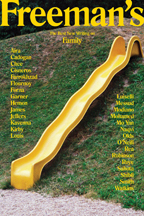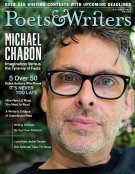How do you find writers for the journal?
I spent fifteen years as a book critic, seven years judging a prize, and four years editing a journal—all of which gave me an excess of enthusiasms. I’m also always searching, because finding the things you don’t know exist is really fun. When I commission a piece, it’s kind of like: Who haven’t I heard from in a while? Or, what do I think someone hasn’t done? For example, in the next issue, Kay Ryan has a short piece about her home. When I interviewed her before, she told me she’s lived in the same house for thirty-five years and that she reroofed it herself. Here’s a MacArthur Genius– and Pulitzer Prize–winning poet sitting on the roof probably doing this all by hand, getting a sunburn. And on top of it, she’s such a great describer of internal space; she thinks of it in very physical terms. Some of what I do is spend time with writers and listen to them tell stories, and often a piece emerges right from what they’re telling you. So it’s a mixture of that, blind submissions, and submissions from agents and people that I’ve watched develop. It’s sort of like if you’re really into birds, everywhere you go, you see and are looking for birds. For me it’s the same way with stories.
 Why did you start Freeman’s?
Why did you start Freeman’s?
I realized I missed editing stories when I left Granta three years ago. I was going to take a break and finish some books—and I did—but right away I started editing an anthology, kind of by accident, about New York and inequality. By the end of it I thought, “What am I doing? Why don’t I do this again?” So rather than apply for jobs or wait for one to come open, I thought it’d be much more interesting to start something new. I figured it was also a little less pressure if the money I was losing was essentially my own and the smallest bit of someone else’s, rather than having to start with an office full of ten people and a subscription agency. Why not just start and see, Okay, can I get this off the ground? And so far it’s worked.
With the release of the second issue, have your aims for Freeman’s changed?
I guess a little bit. I’m teaching a class on the journal at the New School and doing more about the history of the journal. In the United States in particular, the journal was attached to the growth of modernism. A lot of little journals published writers like H. D. and Hemingway first—Ezra Pound was basically everyone’s contributing editor—but they had a lot more power than they had readership. All of them were attached to salons, which were run by, or funded by, wealthy individuals. And I realized that by publishing Freeman’s this way [with each issue accompanied by many events and readings] I’m trying to invert that scenario. I want the journal to feel like a salon, but I also want to it also feel like an accessible salon for readers. That if they live in Sacramento, or Minneapolis, or Miami, or Barnes, Kansas, they can go and participate in an event. That the pieces in the journal rise up through their storytelling. And I think that’s an important step for literary journals—if not mine, then someone else’s—to take forward, because I think for too long they’ve been an elitist institution. Obviously they have small acceptance rates because they get lots of submissions, but I’m talking more about their interaction with culture at large and their readers and their assessment of who their readers are and can be.
How do you sequence the pieces or create the overall arc of the journal?
The short pieces come first. With Granta, I used to start with the big piece, because I thought, “This is why people read journals: to get these twelve thousand words.” With Freeman’s, I kind of feel like people need a bit of a warm-up. I also feel like the first of those short pieces has to open up possibilities in different pieces. And then the first long piece has to do the same thing, so that there can be like a prelude and an opening movement that creates a series of notes that other pieces can play with. That doesn’t make shorter pieces any lesser. But it does mean that with a long piece like Aminatta Forna’s piece “Crossroads,” which does a lot of different things—it’s talking about belonging, it’s talking about history, it’s talking about migration, it’s talking about adoption, it’s talking about biracial family life, it’s talking about parents and grandparents—if I put it at the beginning, it allows the other pieces to be themselves. I also try to balance pieces that are humorous, or that have humor, with ones that are more somber.
This second issue was originally going to be the humor issue. I knew from the beginning that I would have at least three or four pieces that were funny all the way through. And in general I feel like literary journals could do better with humor. I also think that in North American life we tend to silo humor and tragedy, or humor and drama—and they don’t have to be that way! You read Chekhov, you read Tanizaki, you read all these humorous writers from elsewhere. I think humor is better when it’s rubbed up against something dark. Otherwise, why don’t you just go be a standup? Even the best standups talk about serious things with comedy.
Why did the issue theme change from humor to family?
Well, you can’t commission humor, I don’t think. If you can, you’re just an editorial ninja. The New Yorker does a very good humor issue, but they also have people and cartoonists whose job is to be funny all the time. In general literary humor is very hard to do, especially when you tell someone to be funny. I think for a lot of writers humor is a coping mechanism, and if you ask someone to cope in advance, it’s like, “What’s wrong with me?” I was talking about this in Australia last week with Helen Garner, and we were talking about humor and its importance. She said, “The best books, like the really really good books, almost all of them are really really funny.” Dickens is funny, Shakespeare’s funny—we sort of went through it, and were trying to find the humorless ones. And those are the ones you feel obligated to read.
How do you approach editing the pieces in Freeman’s?
Everyone’s different. I can’t approach everyone with the same method—I’m the child of two social workers and they came from a very process-oriented method of listening. But I don’t think there’s a process or method of listening that can be applied to twenty-nine different writers. I think everyone has different needs as individuals and writers. Some people don’t need any help at all; I can virtually just put their piece into the design program and ship it off. Other people need a lot more collaboration. So I have to be flexible that way. Some people need really long deadlines, while with some people I can say, “I need this next week,” and they’ll hurry up and write it. Part of the pleasure of editing is finding that interaction that creates the proper interaction. It’s like when you first meet someone, you calibrate—and that’s what I think editing requires.
Do you work with other editors on the journal?
I’m starting to work more with Allison Malecha at Grove. Peter Blackstock helped me get the first issue into production, but all the editing was done by me. This is the second issue I’m working on with Allison, and she’s really good, as is Peter—Peter edited Viet Thanh Nguyen’s The Sympathizer. And he speaks five languages and Allison speaks three. I’m still going to make the call [on pieces] myself, but it’s nice to have a collective. It’s good to have people to bounce things off of, but also people who can see things that maybe I wouldn’t see. I loved having that at Granta, having four or five other editors, but it’s a very expensive proposition.
Can people submit to Freeman’s, and if so how?
I just finally put up a website for Freeman’s, and I think we’re going to put up some sort of submission queue. For the last year and a half I’ve just been trying to spread the word through social media and through literary channels like agents and editors. So I’ve been getting a fair number of submissions. But I wanted the first two issues to really say, “Okay, this is where I’m calling from.” I hope that makes it easier for people to submit and know if this is the kind of space they want to be involved in. Because there are so many journals out there. I found that once we opened Grantato Submittable, the number of submissions went up to like three hundred a week. And there was something important in making someone go to a postbox, put something in an envelope, put on the dollar eighty or two thirty, and ship it overseas and wait. And I was lucky—we pulled someone out of slush almost every issue. I want to start doing that with Freeman’s. In the first issue we published Fatin Abbas, and it’s her first piece of fiction; I found out about her through Colum McCann. But I want it to be more open than that, not just a friend’s student. I really want to be surprised from something that comes out of nowhere. There will be a more official channel for submissions soon. But until then, people find me on Facebook or Twitter and I’ll write back and say, “Send it to me.”
Dana Isokawa is the associate editor of Poets & Writers Magazine.








